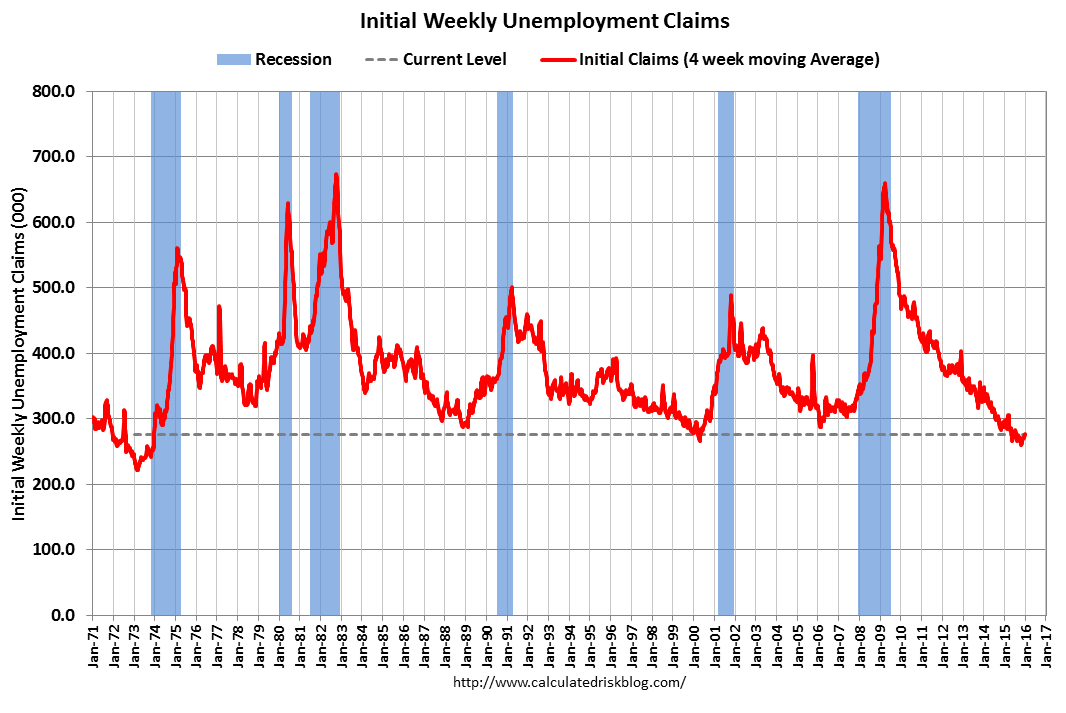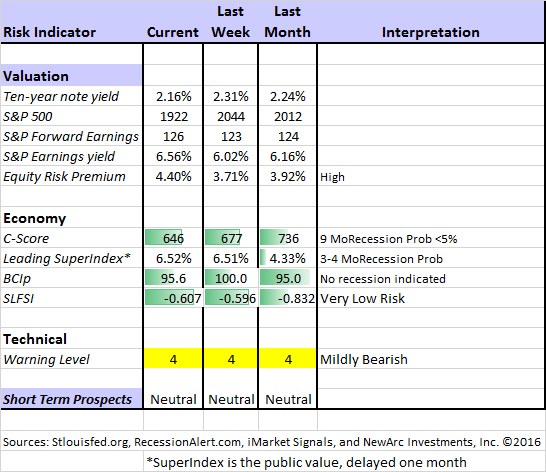After the worst start in history for U.S. stocks, everyone will be searching for meaning. One S&P 500 strategy has worked for almost seven years, but what about now?
Is it time to “buy the dip?”
Prior Theme Recap
In my last WTWA I predicted that the start of a new year would focus attention on one of the several different “January effects.” This proved to be a secondary consideration. Instead, news from China rippled around the world, pressuring U.S. trading before Monday’s opening. The China story continued through Thursday. Even a strong employment report on Friday could not reverse the selling pressure. There are some still debating the seasonal effects, but it was a minor theme last week. You can see the sad story for stocks from Doug Short’s weekly chart. (With the ever-increasing effects from foreign markets, you should also add Doug’s World Markets Weekend Update to your reading list).

Doug’s update also provides multi-year context. See his full post for more excellent charts and analysis.
We would all like to know the direction of the market in advance. Good luck with that! Second best is planning what to look for and how to react. That is the purpose of considering possible themes for the week ahead. You can make your own predictions in the comments.
This Week’s Theme
There are plenty of important data releases this week, but I expect a focus on interpreting last week’s selling. Since the market bottom in 2009, it has been a winning strategy to buy every “dip.” The problem is that dips cannot be identified until they are over! Expect a spirited debate next week, with observers asking –
Is it once again time to “buy the dip?”
Here is a preview of what to expect:
.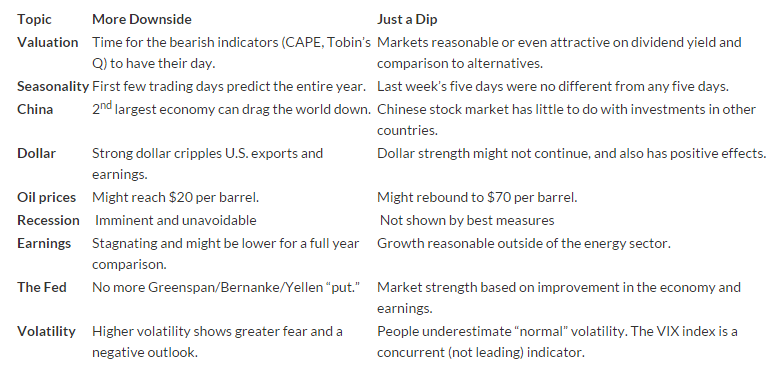
As always, I have my own opinion in the conclusion. But first, let us do our regular update of the last week’s news and data. Readers, especially those new to this series, will benefit from reading the background information.
Last Week’s Data
Each week I break down events into good and bad. Often there is “ugly” and on rare occasion something really good. My working definition of “good” has two components:
- The news is market-friendly. Our personal policy preferences are not relevant for this test. And especially – no politics.
- It is better than expectations.
The Good
Despite the negative result for stocks, there was plenty of good news last week.
- ISM non-manufacturing remained strong at a level of 55.3, a touch below expectations.
- Bullish sentiment makes a new low. Bespoke has the story and this chart:
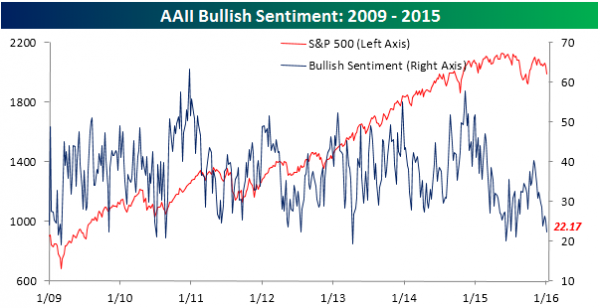
Initial jobless claims continued to decline with the four-week moving average under 276K. Calculated Risk has the story.
- Private job growth was strong – a gain of 257K according to the ADP report.
- The employment report was very strong.
- The WSJ has an excellent summary of the numbers.
- The quality of new jobs has also improved. (Philly Fed report via GEI).
- James Picerno’s analysis emphasizes the long view, including this chart.

The Bad
Some of the economic data was disappointing.
- ISM manufacturing was in contraction territory (48.2) and also missed expectations.
- Auto sales fell to a seasonally adjusted annual rate of 17.34 million, the lowest rate since June. On the bright side, truck sales were up 8% on a year-over-year basis.
- Construction spending fell by 0.4% when a 0.7% gain was expected.
- Factory orders missed expectations with a small m-o-m loss.
- Wholesale sales disappointed. Steven Hansen of GEI describes inventories as at “levels associated with recessions.”
The Ugly
North Korea. A hydrogen bomb in the hands of a country that views radio broadcasts as an act of war is dangerous. The NYT has a good account of the bomb story and The Guardian covers the radio news.
The Silver Bullet
I occasionally give the Silver Bullet award to someone who takes up an unpopular or thankless cause, doing the real work to demonstrate the facts. Think of The Lone Ranger. No award this week, but you will enjoy our review of last year’s winners. I think you will find the summary fun to read, and the lessons still quite timely.
Noteworthy
How do millennials spend their time now as opposed to 10 years ago? One category shows a 25% increase. (Priceonomics)
Quant Corner
Whether a trader or an investor, you need to understand risk. I monitor many quantitative reports and highlight the best methods in this weekly update. Beginning last week I made some changes in our regular table, separating three different ways of considering risk. For valuation I report the equity risk premium. This is the difference between what we expect stocks to earn in the next twelve months and the return from the U.S. 10-Year Treasury note. I have found this approach to be an effective method for measuring market perception of stock risk. This is now easier to monitor because of the excellent work of Brian Gilmartin, whose analysis of the Thomson-Reuters data is our principal source for forward earnings.
Our economic risk indicators have not changed.
In our monitoring of market technical risk, I am using our “new” Oscar model. I put “new” in quotes because Oscar is in the same tradition as Felix and the product of extensive testing. We have found that the overall market indication is more helpful for those investing or trading individual stocks. The score ranges from 1 to 5, with 5 representing a high warning level. The 2-4 range is acceptable for stock trading, with various levels of caution.
Oscar improves trading results by taking some profits during good times and getting out of the market when technical risk is high. This is not market timing as we normally think of it, since it is not an effort to pick tops and bottoms and it does not go short. Instead, Oscar identifies and limits risk. (More to come about Oscar).
I considered continuing to report the Felix updates, but I already have a distinction between long and short-term methods. I want to minimize confusion. Those who want this information can subscribe to our weekly Felix updates.
In my continuing effort to provide an effective investor summary of the most important economic data I have added Georg Vrba’s Business Cycle Index, which we have frequently cited in this space. In contrast to the ECRI “black box” approach, Georg provides a full description of the model and the components.
For more information on each source, check here.
Recent Expert Commentary on Recession Odds and Market Trends
Bob Dieli does a monthly update (subscription required) after the employment report and also a monthly overview analysis. He follows many concurrent indicators to supplement our featured “C Score.”
RecessionAlert: A variety of strong quantitative indicators for both economic and market analysis. While we feature the recession analysis, Dwaine also has a number of interesting systems. These include approaches helpful in both economic and market timing. He has been very accurate in helping people to stay on the right side of the market.
Georg Vrba: provides an array of interesting systems. Check out his site for the full story. We especially like his unemployment rate recession indicator, confirming that there is no recession signal. He gets a similar result with the twenty-week forward look from the Business Cycle Indicator, updated weekly and now part of our featured indicators.
Check out Georg’s new mutual fund analysis tool. You can easily see how your fund has done on this fee-adjusted ratings scale.
Doug Short: Provides an array of important economic updates including the best charts around. One of these is monitoring the ECRI’s business cycle analysis, as his associate Jill Mislinski does in this week’s update. His Big Four update is the single best visual update of the indicators used in official recession dating. You can see each element and the aggregate, along with a table of the data. The full article is loaded with charts and analysis. This week’s update shows the continued strength of employment, as well as the importance of next week’s data on retail sales and industrial production.
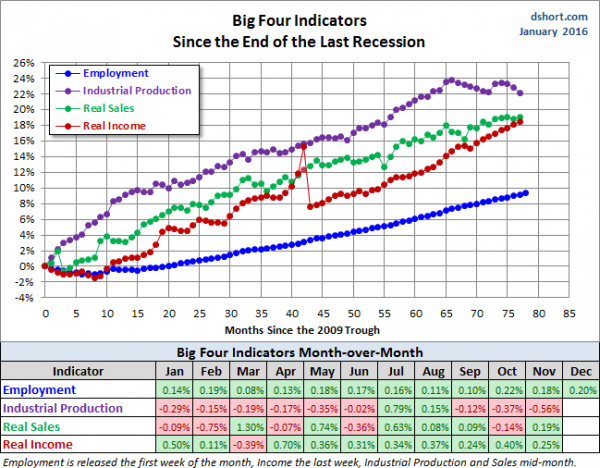
This chart from Scott Grannis illustrates why we have added the equity risk premium to our table. He writes as follows:
The chart … shows the difference between the earnings yield on stocks and the yield on risk-free 10-yr Treasury bonds. It’s unusual for the equity risk premium to be as high as it is today. Investors would not remain indifferent to such high yields on equity securities vis a vis their risk-free counterparts unless they expected earnings to decline in the future. Bad news is priced in.

The Week Ahead
This is a big week for economic data, including several of the most important reports, as well as some catching up from the holidays. While I highlight the most important items, you can get an excellent comprehensive listing at Investing.com. You can filter for country, type of report, and other factors.
The “A List” includes the following:
- Fed Beige Book (W). Anecdotal evidence the Fed has at their next meeting.
- Initial Claims (Th). The best concurrent news on employment trends, with emphasis on job losses.
- Michigan Sentiment (F). Concurrent read on spending and employment.
- JOLTS (T). Used by the Fed to check tightness of labor market.
- Retail Sales (F). Special interest in the December data – holiday spending.
The “B List” includes the following:
- PPI (F). Eventually this will matter.
- Industrial Production (F). Volatile series but important for GDP.
- Business Inventories (F). Part of the GDP calculation. Only reason for interest in this November data.
- Crude oil inventories (W). Attracting a lot more attention these days.
President Obama’s last State of the Union address will be Tuesday night. FedSpeak is light. We’ll have some early earnings updates. Geopolitical news may continue to take center stage.
How to Use the Weekly Data Updates
In the WTWA series I try to share what I am thinking as I prepare for the coming week. I write each post as if I were speaking directly to one of my clients. Each client is different, so I have five different programs ranging from very conservative bond ladders to very aggressive trading programs. It is not a “one size fits all” approach.
To get the maximum benefit from my updates you need to have a self-assessment of your objectives. Are you most interested in preserving wealth? Or like most of us, do you still need to create wealth? How much risk is right for your temperament and circumstances?
My weekly insights often suggest a different course of action depending upon your objectives and time frames. They also accurately describe what I am doing in the programs I manage.
Insight for Traders
Oscar continues both the neutral market forecast, and the bearish lean. We are still about 35% invested in this program. There are often plenty of good investments, even in an expected flat market, but the cash certainly provided a cushion for Oscar last week. For more information, I have posted a further description — Meet Felix and Oscar. You can sign up for Felix and Oscar’s weekly ratings updates via email to etf at newarc dot com. They appear almost every day at Scutify (follow here).
Dr. Brett Steenbarger explains why traders need to find their niche:
An independent trader similarly needs to find strategies that are unique, that exploit opportunities in the marketplace, and that cannot be readily duplicated. Taking a generic trading approach to a crowded, competitive marketplace is a sure way to not achieve distinguished results.
Gatis Roze explains the importance of emphasizing your process and looking past losses. The entire article is interesting, including some good lessons. I liked this short summary:
Allow yourself to accept the fact that even an exceptional investor with a great trading system will incur losses. Protect your self-confidence by understanding that the past cannot be changed. Stay focused, be proactive and look ahead so that you are able to approach the next trade in an unbiased manner. Did you get that? The same thing that makes a great marriage is what makes a great investor – a short memory.
And Roze also includes some surprising words from Mrs. OldProf’s favorite coach (she is from Green Bay):
Bottomline: I leave you with two comments – one made by an extraordinary coach and the other by an exceptional trader.
“If you can’t accept losing, you can’t win” — Vince Lombardi
“My plan of trading was sound enough and won oftener than it lost. If I had stuck to it, I’d have been right perhaps as often as 7 out of 10 times.” — Jesse Livermore
Insight for Investors
I review the themes here each week and refresh when needed. For investors, as we would expect, the key ideas may stay on the list longer than the updates for traders. Major market declines occur after business cycle peaks, sparked by severely declining earnings. Our methods are focused on limiting this risk. Start with our Tips for Individual Investors and follow the links.
We also have a page (just updated!) summarizing many of the current investor fears. If you read something scary, this is a good place to do some fact checking. Pick a topic and give it a try.
Other Advice
Here is our collection of great investor advice for this week.
If I had to pick a single most important source, it would be it would be Cass R. Sunstein’s report on How Facebook Makes Us Dumber. This Bloomberg View story summarizes a study analyzing Facebook posts for a five-year period. As sophisticated readers would expect, there is a strong tendency to seek out like-minded people and to confirm existing views. The key point is the power of this effect on social media.
Of the various explanations for group polarization, the most relevant involves a potentially insidious effect of confirmation itself. Once people discover that others agree with them, they become more confident — and then more extreme.
In that sense, confirmation bias is self-reinforcing, producing a vicious spiral. If people begin with a certain belief, and find information that confirms it, they will intensify their commitment to that very belief, thus strengthening their bias.
Stock and Fund Ideas
Andrew Bary’s Barron’s cover story discusses valuation as well as some specific stock ideas.
This could be a year when value-oriented stocks beat their growth counterparts, after one of the worst years of relative performance for value. Growth stocks in the S&P 500 bested the index’s value components in 2015 by nine percentage points.
Winners this year could include Apple (O:AAPL) and Intel (O:INTC), Merck (N:MRK) and Pfizer (N:PFE), Ford Motor (N:F) and General Motors (N:GM), Dow Chemical (N:DOW), and major financials like JPMorgan Chase (N:JPM), Citigroup (N:C), Bank of America (N:BAC), and Goldman Sachs (N:GS). Some battered retailers already are getting a lift, including Wal-Mart Stores (N:WMT) and Macy’s (N:M).
How about biotech? The fundamentals of this sector continue to improve and this week’s J.P Morgan health care conference often has a favorable, focusing effect. (Stat)
Energy
Oil prices might head much lower (Oppenheimer via Clayton Browne at ValueWalk).
Or maybe prices will rebound. T. Boone Pickens was wrong last year, but he has made a lot of money in the oil business. He thinks that prices have bottomed. Watch the entire interview to reach your own conclusion, but he makes a key point: The supply/demand imbalance is only 1%.
Personal Finance
Professional investors and traders have been making Abnormal Returns a daily stop for over ten years. The average investor should make time (even if not able to read every day as I do) for a weekly trip on Wednesday. Tadas always has first-rate links for investors in this special edition. There are several great links, but I especially liked this advice about junk bonds. The article was written for investment advisors, but much of this helpful information is available to all.
Things can get worse before they get better, says Collin Martin, director of fixed income at Charles Schwab Center for Financial Research in New York. We think there will be bouts of volatility in 2016. At some point, there will be buying opportunities, but not just yet.
This week Tadas also features the “cottage industry of index card finance.” The key is to simplify and identify the most important points for your personal situation. Tadas explains it well and, as we would expect, provides many helpful links.
Stop what you are doing. Sit down with a 4″x6″ index card and see if you can write down, as simply, as possible, your philosophy on savings, spending and investing. My guess is that for most it will be a difficult task.
Many people find this difficult to do on their own, as I often learn when helping prospective clients. Part of the problem is a matter of asking the right questions. For those who would prefer an audio version, public radio had a good show on the topic.
Watch out for…
Two good warnings this week come from Barry Ritholtz:
- Smart investors do not try to time the market.
- The do’s and don’ts of a market crash. Hint: You need discipline and a plan.
Final Thoughts
Traders may still need some fancy footwork in the next few weeks. Perhaps Oscar is right in getting smaller than usual.
For investors, I see the current selling as one of the regular (and basically unpredictable) pullbacks. It is always interesting when Barron’s emphasizes some themes I have in mind. This week I could have written several of the lead articles, since they are all topics I have covered in the past.
- Valuations are reasonable, and some stocks are very attractive. Barron’s cover story cites several of our favored stocks and sectors.
- China concerns are exaggerated. (Barron’s and Jeff).
- The VIX does not predict the future. (Barron’s and Jeff’s long list of posts on this topic).
While Barron’s did not cover the other points in today’s introductory table, I have. Looking at the last year in the dollar or oil prices is simply a form of recency bias. The long range dollar value on a trade-weighted basis is pretty stable. Earnings outside of energy are showing modest growth. The best recession forecasting methods do not signal danger.
For investors, especially those in the Buffett value tradition, there are plenty of great candidates – just as there were last year. If you favor this approach and have cash, you have a chance to buy at some attractive prices. If you are already fully invested, you have a chance to adopt a different asset allocation.
Stocks in biotech, auto, homebuilders, and banking did not suddenly lose 5 – 10% of their actual value because of China or oil prices.

